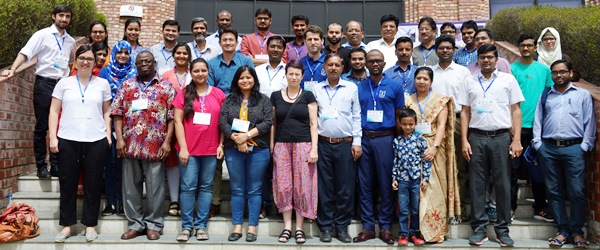IUSSP Seminar on Mortality analysis and forecastingNew Delhi, India, 6-8 April 2017 Organized by the IUSSP Scientific Panel on Lifespan Extension with Varying Cause-of-death Trajectories, in collaboration with Jawaharlal Nehru University (JNU), Max Planck Odense Center (MaxO) and the Australian National University (ANU). Organizing Committee:
The International Seminar on Mortality Analysis and Forecasting was held 6-8 April 2017 at the Jawaharlal Nehru University, in New Delhi, India. The meeting received generous support from the Danish Agency for Science, Technology and Innovation as well as from Jawaharlal Nehru University.
The scientific programme consisted in 24 presentations in regular sessions and 11 flash presentations (3-4 minute presentations of slides focusing on the highlights of a poster). The third day of the meeting was devoted to providing hands-on training in R on mortality analysis to PhD students who had attended the seminar. A total of 35 presenters and 15 additional researchers participated in the seminar. Participants represented a variety of disciplines – demographers, statisticians, economists and public health specialists – and included senior reserachers, junior faculty as well as PhD or master students from the Centre for the Study of Regional Development (CSRD) at JNU.
The seminar focused on themes related to mortality and causes of death studies in India and the region, and forecasting methodologies in international settings, as well as methodologies for countries with limited data. The goal of the seminar was not to answer a single question but to try to bring together researchers from developing and developed countries with an interest in mortality. More specifically, the objectives of the seminar were: i) to present studies on the past and present of mortality and causes of death in India and the region; ii) to highlight new methodologies on mortality forecasting; and iii) to discuss possible forecasting methodologies to be used for countries with deficient data.
Among the serious concerns discussed at the meeting was the availability of reliable data on deaths and population. For example, the National Statistical Office of India does not publish yearly death counts by age and sex, but produces already modeled life tables. This discussion was further highlighted when colleagues from the “Million deaths study” presented their data, but did not have a date for the possible public dissemination of the information to researchers. Researchers have had to use alternative data sources to do their demographic work, and very inventive sources of information were highlighted during the seminar. Although not discussed a new source of data has started in India which could change completely the paradigm of data information in the country, namely the scanning of 1.2 billion people in the Aadhaar project. It would be vital for the future work of demographers in the country that this information also is made available to researchers.
Read also:
|
|






